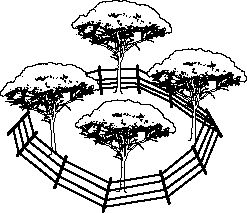Grazing animals can cause extensive damage to trees, both young and old. Seedlings are removed and mature trees chewed, bunted and rubbed against by goats, sheep and cattle.
Horses are particularly destructive animals and can ringbark a mature tree overnight or even completely remove it in a matter of days.
Livestock also erode and compact the surrounding soil and often contribute to the declining health of a tree.
Opinions vary as to why livestock attack trees. Horses may chew the bark (ringbarking) to compensate for a shortage of minerals or fibres, hunger or boredom.
Farmers and small property owners can use a variety of methods to successfully protect their young and mature trees.
Permanent fencing
Trees need protection from ringbarking, leaf grazing, bunting and rubbing. Without protection, trees may be completely removed by grazing animals.
Permanent fencing around young trees can be constructed so that it will continue to provide protection once the tree matures. Permanent fencing can also be erected around mature trees. A permanent fence can be erected around a single tree, an area of trees or a line of trees.
For horse fences, leave enough space between the fence and the tree so that horses cannot reach the leaves by stretching their necks. Avoid rough edges that may injure stock, and do not use barbed wire if the paddock is for horses.
If electric fencing is already being used on the farm, it is easy to add an additional fence. If you wish to install electric fencing, it is important to plan carefully to ensure the fence is effective.
To protect a tree close to an existing fence, connect high tensile wires to the fence and hoop them around the tree. Use a post or two to support the hoops.
To protect a clump of trees in a paddock where horses are not kept, a permanent fence can be placed around them that is relatively cheap and takes little time to erect. It consists of barbed wire and sloping posts.
The posts are driven into the ground at an angle of 30ᵒ to the vertical and leaning into the trees. They are spaced 5m apart. The barbed wire is hand-pulled across the posts and tied to them.
Place the bottom wire close to the ground. A fence, consisting of five wires should exclude sheep, while three wires are likely to prevent calves and cows entering the enclosed area. To allow for restricted grazing under the trees, install a gate.

Protecting mature trees
To allow unrestricted access to the area surrounding a mature tree (for shade or grazing) while maintaining some protection from ringbarking, attach small-netted wire around the tree trunk, from the ground to a height above the reach of livestock.
Do not use wire with a net size larger than chicken wire as it may catch their hooves.
Attach the wire in a way that will not injure the stock and will permit future growth of the trees. Also keep the wire free from the tree as diameter growth will cause gaps in a few years. This problem can be avoided by joining the two wire ends with tyre tube to allow for expansion.
Remember that allowing stock to graze freely around trees may damage the root system and degrade soil structure. This will affect the health of the tree and may eventually result in its death.
Protecting young trees
Whist fencing is the best way to protect young trees from horses and other large livestock, there are many imaginative ways to protect them from small livestock. These include:
- plastic tree guards and bamboo stakes
- stacking used tyres over the tree. The tyres can be kept in place using three star steel posts driven into the ground
- using an old drum, kept in place with a triangle of steel posts. Wire mesh could be added to the top of the drum for further protection as the tree grows
- constructing a guard around the trees using old wooden fence posts.
Trees in stockyards and exercise yards
Trees in stockyards and exercise yards can be both a nuisance and a liability to livestock and their owners. Stockyards are often stocked heavily or contain agitated animals and in these situations trees and wire netting can cause injury.
Trees are best situated outside the yard, close to the fence, where they can provide shade and shelter without causing any injuries. If this is not possible, locate trees close to corners of the yard and fence them in with planks of wood.
Non-physical barriers to tree damage
Whilst the methods outlined above are the most effective ways to protect trees from livestock damage, some people claim that the following non-physical methods are effective deterrents.
Using mineral licks. These have been found to be effective in the past. However, it is not known if the licks diverted attention from the tree or indicated a lack of minerals in the livestock feed that was previously supplied by the trees.
Spraying or planting the areas around the tree with garlic.
Applying a mixture of manure and water to the trunk of the tree. Animals such as horses do not eat near areas where they can smell their own manure. This helps them to reduce their parasite burden. Deterrents which apply any substance to the tree become less effective as time passes.
Agroforestry research has shown that smooth barked species are able to be grown in conjunction with most grazing animals, providing that they have been protected from stock in the first three to four years. Rough barked species are prone to browsing damage (e.g. sheep and dairy cows/calves).
None of these methods should be used to protect young trees against damage.


